- Understanding Ampel Petunia
- Light and Temperature Requirements
- Watering and Fertilization
- Pruning and Deadheading
- Pest and Disease Control
- Importance of Timely Transplanting
- Factors Affecting Seedling Growth
- 1. Light
- 2. Temperature
- 3. Watering
- 4. Nutrients
- 5. Air Circulation
- 6. Transplanting
- 7. Pest and Disease Management
- 8. Genetics
- Choosing the Right Transplanting Time
- Consider the Weather
- Observe the Seedling’s Growth
- Consider the Growing Time
- Take Careful Note of Transplant Shock
- Conclusion
- Transplanting Techniques for Ampel Petunias
- 1. Timing
- 2. Container Size
- 3. Soil Preparation
- 4. Transplanting Process
- 5. Watering and Care
- 6. Fertilization
- 7. Pruning
- Care Tips for Transplanted Seedlings
- 1. Watering
- 2. Fertilizing
- 3. Sunlight
- 4. Pruning
- 5. Support
- 6. Pest and Disease Control
- Benefits of Timely Transplanting
- Troubleshooting Common Issues
- 1. Yellow leaves
- 2. Leaf spots
- 3. Stunted growth
- 4. Delayed flowering
- Questions and Answers:
- Why is timely transplanting important for ampel petunias?
- When is the best time to transplant ampel petunias?
- What happens if ampel petunias are transplanted too late?
- How can overexpression of seedlings affect ampel petunias?
- What should I do if my ampel petunias are overexpressed?
- Can I transplant ampel petunias directly into the ground?
- How often should I water ampel petunias after transplanting?
- Videos: ✅ How to Grow Petunias from Seed – Start to Finish.
Transplanting is a crucial step in the process of growing ampel petunias, a popular flowering plant known for its cascading blooms. Proper timing and technique are essential to promote healthy growth and ensure optimal flowering. Overexpression of seedlings can lead to problems such as overcrowding, weak plants, and delayed or reduced flowering. Therefore, it is important to understand the best practices for timely transplanting to maximize the beauty and longevity of ampel petunias in your garden.
One key aspect of timely transplanting is determining the appropriate stage of development for the seedlings. Ampel petunias typically require 4-6 weeks of growth from the time of sowing the seeds to reach a suitable size for transplantation. The seedlings should have developed a healthy root system and have at least two sets of true leaves before they can be safely transplanted into their final containers or hanging baskets.
Timing is also crucial when it comes to transplanting ampel petunias. It is important to wait until all risk of frost has passed and the weather has warmed up consistently. Transplanting too early, when the soil is still cold or when there is a possibility of frost, can stunt the growth of the seedlings and lead to their demise. Instead, aim to transplant your ampel petunias when the soil temperature has reached a consistent 60 degrees Fahrenheit or above.
When transplanting ampel petunias, proper technique is essential for minimizing damage to the roots and promoting successful establishment. Gently loosen the seedlings from their starting containers and carefully lift them out, being mindful not to damage the delicate roots. Make sure to dig a hole in the final container or hanging basket that is deep and wide enough to accommodate the root system without crowding or bending the roots.
By following these guidelines for timely transplanting, you can avoid the overexpression of ampel petunia seedlings and promote healthy growth and abundant flowering. Remember to choose an appropriate stage of development, wait for suitable weather conditions, and handle the seedlings with care during the transplantation process. With proper care, your ampel petunias will thrive and provide a stunning display of cascading blooms throughout the season.
Understanding Ampel Petunia
Ampel Petunia, also known as trailing petunia, is a variety of petunia that is known for its cascading growth habit. It is a popular choice for hanging baskets, window boxes, and containers, as its trailing stems can grow up to several feet long.
Ampel Petunia is a hybrid variety that is derived from the species Petunia × atkinsiana. It is known for its vibrant and colorful flowers, which come in a wide range of shades, including pink, purple, red, white, and blue. The flowers have a trumpet shape and are often fragrant, adding to their appeal.
One of the key features of Ampel Petunia is its ability to produce a large number of flowers. This makes it an excellent choice for adding a pop of color to any outdoor space. However, in order to ensure optimal flowering, it is important to provide the right conditions and care for the plants.
Light and Temperature Requirements
Ampel Petunia thrives in full sun conditions, so it is important to place the plants in a location where they can receive at least 6-8 hours of direct sunlight each day. Additionally, they prefer mild temperatures between 70-80°F (21-27°C). Extreme heat or cold can affect the growth and flowering of the plants.
Watering and Fertilization
Proper watering is essential for the health and vigor of Ampel Petunia. The plants should be watered regularly, ensuring that the soil is evenly moist but not waterlogged. It is important to avoid overwatering, as this can lead to root rot and other problems.
Fertilization is also important for promoting healthy growth and abundant flowering. Ampel Petunia benefits from regular feeding with a balanced, water-soluble fertilizer. This should be applied according to the manufacturer’s instructions, usually every 2-3 weeks during the growing season.
Pruning and Deadheading
To encourage a bushier and more compact growth habit, it is recommended to pinch back the stems of Ampel Petunia when they are about 4-6 inches long. This will promote branching and result in a fuller plant.
Deadheading, or the removal of spent flowers, is also important for prolonging the flowering period of Ampel Petunia. This can be done by simply pinching off the faded flowers or by using scissors or pruners. Regular deadheading will prevent the plants from wasting energy on seed production and instead encourage them to produce more flowers.
Pest and Disease Control
Ampel Petunia is generally a hardy and disease-resistant plant. However, it can be susceptible to common garden pests such as aphids, slugs, and snails. Regular inspection and prompt action can help prevent infestations. Additionally, providing proper air circulation and avoiding excessive moisture can help prevent fungal diseases.
In conclusion, Ampel Petunia is a beautiful and versatile plant that can add a touch of color and elegance to any outdoor space. By providing the right conditions and care, such as proper lighting, watering, pruning, and pest control, gardeners can ensure optimal growth and flowering of this stunning plant.
Importance of Timely Transplanting
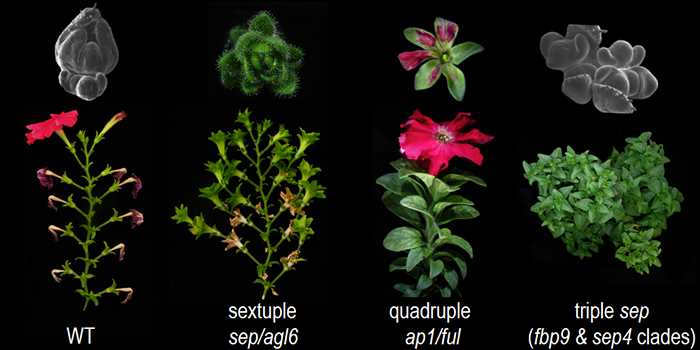
Timely transplanting is crucial for the successful growth and optimal flowering of ampel petunia seedlings. It involves transferring the young plants from their initial containers to larger pots or directly into the ground. This process allows the seedlings to establish stronger root systems and provides them with adequate space to grow and thrive.
Transplanting ampel petunia seedlings at the right time is important for several reasons:
- Promotes root development: Timely transplanting helps the seedlings develop a strong and healthy root system. This allows them to absorb water and nutrients more efficiently, leading to overall better growth and flowering.
- Prevents overcrowding: As ampel petunia seedlings grow, they require more space to expand their roots and foliage. Transplanting them into larger pots or spacing them adequately when planting directly in the ground prevents overcrowding, reduces competition for resources, and ensures optimal growth.
- Enhances flower formation: By transplanting seedlings at the right time, you give them the opportunity to focus their energy on flower production. Overexpressing the seedlings by keeping them in small containers for too long can hinder flower formation and result in delayed or reduced blooming.
- Improves plant vigor: Transplanting ampel petunia seedlings in a timely manner promotes overall plant vigor. It encourages strong, robust growth, increases resistance to diseases and pests, and enhances the plant’s ability to withstand environmental stressors.
In conclusion, timely transplanting is essential for successful ampel petunia cultivation. It plays a crucial role in root development, prevents overcrowding, enhances flower formation, and improves overall plant vigor. By following the appropriate transplanting guidelines, you can ensure optimal growth and abundant flowering in your ampel petunias.
Factors Affecting Seedling Growth
Several factors can influence the growth of ampel petunia seedlings. It is essential to understand these factors to ensure optimal growth and flowering of the plants.
1. Light
Light is crucial for photosynthesis, the process through which plants convert light energy into chemical energy. Insufficient light can lead to weak and elongated seedlings, while excessive light can cause scorching or wilting. Providing adequate light, such as through the use of grow lights, is important to promote healthy seedling growth.
2. Temperature
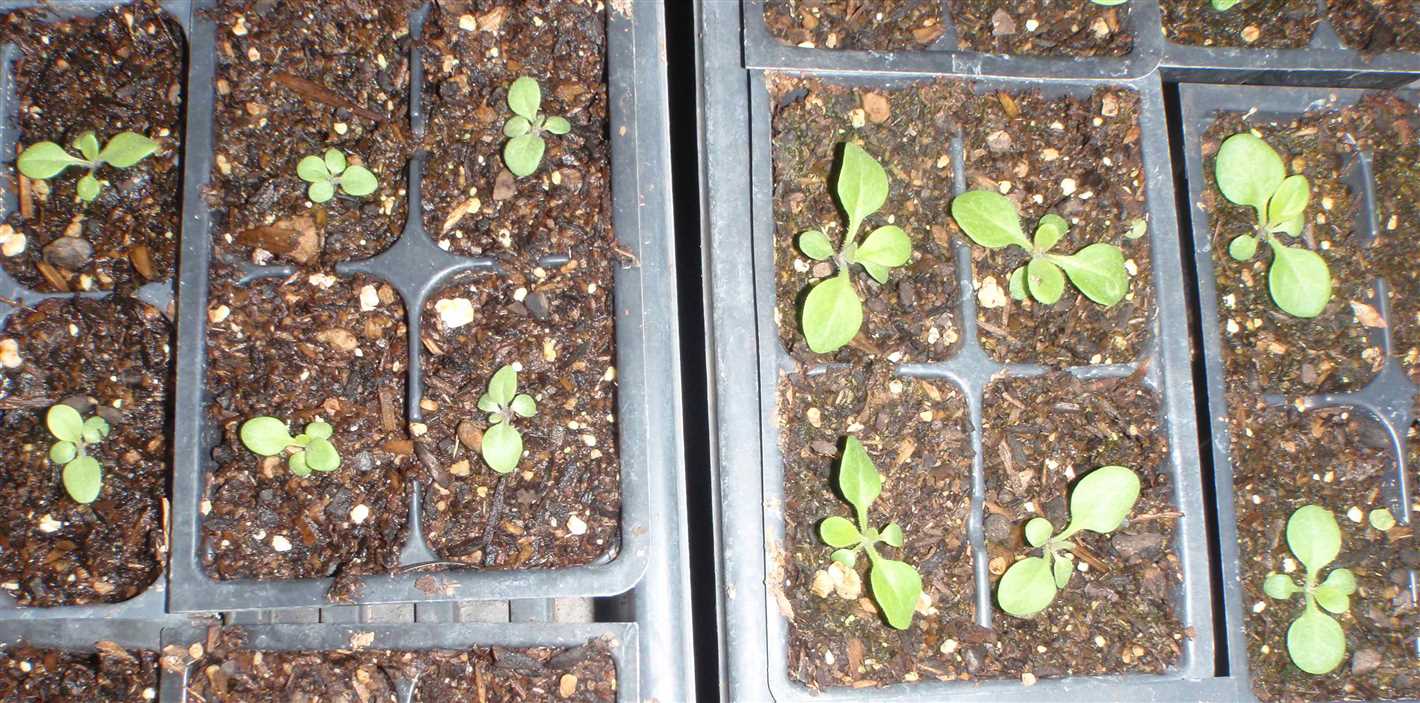
Temperature plays a significant role in seedling growth. Different plant species have specific temperature requirements for optimal growth. Ampel petunias generally thrive in temperatures between 65°F and 75°F (18°C and 24°C) during the day, and around 55°F to 60°F (13°C to 16°C) at night. Fluctuations in temperature or extreme temperatures can negatively impact seedling development.
3. Watering
Proper watering is essential for seedling growth. Overwatering can lead to root rot and other diseases, while underwatering can cause seedlings to wilt and stunt their growth. It is important to maintain a balance and provide adequate moisture to the seedlings. Monitoring the soil moisture level and watering when needed is crucial.
4. Nutrients
Ampel petunia seedlings require essential nutrients for healthy growth. The use of a well-balanced, nutrient-rich soil or a suitable potting mix is important. Additionally, incorporating a slow-release fertilizer or supplementing with liquid fertilizer can ensure that the seedlings receive the necessary nutrients for optimal growth.
5. Air Circulation
Good air circulation is important for seedling growth, as it helps prevent the development of fungal diseases. Ensuring proper ventilation and avoiding overcrowding of seedlings can promote healthier growth by minimizing the risk of diseases and providing adequate oxygen to the roots.
6. Transplanting
Transplanting seedlings at the right time is crucial for their growth. Delaying transplanting can lead to overcrowding, competition for resources, and stunted growth. On the other hand, transplanting too early can result in transplant shock. It is essential to follow the recommended guidelines for transplanting ampel petunia seedlings to ensure successful growth.
7. Pest and Disease Management
Pests like aphids, whiteflies, and diseases like powdery mildew can significantly damage seedlings. Implementing proper pest and disease management practices, such as regular monitoring, using organic pesticides, and maintaining good hygiene, can help prevent damage and promote healthy seedling growth.
8. Genetics
The genetics of the ampel petunia variety can also play a role in seedling growth. Different varieties may have different growth habits, such as compact or trailing, which can affect the overall growth and flowering of the seedlings. Selecting appropriate varieties based on desired growth characteristics is important for successful cultivation.
By considering these factors and providing the ideal conditions for ampel petunia seedling growth, it is possible to achieve optimal flowering and overall plant health.
Choosing the Right Transplanting Time
Transplanting ampel petunia seedlings at the right time is crucial for achieving optimal flowering. This section will guide you on how to choose the ideal transplanting time for your petunias.
Consider the Weather

Before transplanting your ampel petunia seedlings, it is important to consider the weather conditions. These flowers thrive in warm temperatures, so it is best to wait until the threat of frost has passed and the soil has warmed up. This typically occurs in late spring or early summer.
Transplanting too early can expose the seedlings to cold temperatures, stunting their growth and hampering their ability to produce flowers.
Observe the Seedling’s Growth
An important factor in determining the right transplanting time is the growth of the seedlings. Petunias are fast growers, and it’s important not to let them become overly crowded in their containers before transplanting.
Monitor the seedlings closely and look for signs that they are outgrowing their containers. This includes the roots becoming root-bound or the stems becoming intertwined. Once you notice these signs, it’s time to transplant.
Consider the Growing Time
Keep in mind the average growth time for ampel petunias when choosing the transplanting time. These flowers typically take around 10 to 12 weeks from sowing seeds to producing their first flowers.
If you have a specific date in mind for when you want your petunias to be in full bloom, you can work backward from that date to determine the best time to transplant the seedlings.
Take Careful Note of Transplant Shock
Transplant shock is a common occurrence when moving seedlings from containers to the garden. To minimize the risk of shock, it is important to handle the seedlings gently and water them well before and after transplanting.
Transplanting during cloudy or cooler weather can also help reduce the stress on the seedlings. Additionally, providing some shade for the first few days after transplanting can help the seedlings adjust to their new environment.
Conclusion
Choosing the right transplanting time is essential for the successful growth and flowering of ampel petunias. By considering the weather, observing the seedling’s growth, and taking note of transplant shock, you can ensure optimal results and enjoy a beautiful display of petunias in your garden.
Transplanting Techniques for Ampel Petunias
Transplanting ampel petunias is an important step in their growth and development. Proper transplanting techniques ensure healthy and vigorous plants that will provide an abundance of beautiful flowers. Here are some key techniques to follow:
1. Timing
It is important to transplant ampel petunias at the right time to avoid stunting their growth. Transplant them when they have developed their first set of true leaves and are no longer dependent on their seedling cotyledons for nutrition. This usually occurs around 3-4 weeks after germination.
2. Container Size
Choose a container that is large enough to accommodate the growing ampel petunia plant. A container with a diameter of at least 10-12 inches is recommended to allow enough space for the roots to spread out. Ensure that the container has drainage holes to prevent waterlogging.
3. Soil Preparation
Prepare a well-draining soil mix for transplanting ampel petunias. Use a combination of peat moss, perlite, and a good quality potting soil. This mix will provide adequate drainage while retaining enough moisture for the plants. Avoid heavy soils that can cause waterlogged conditions.
4. Transplanting Process
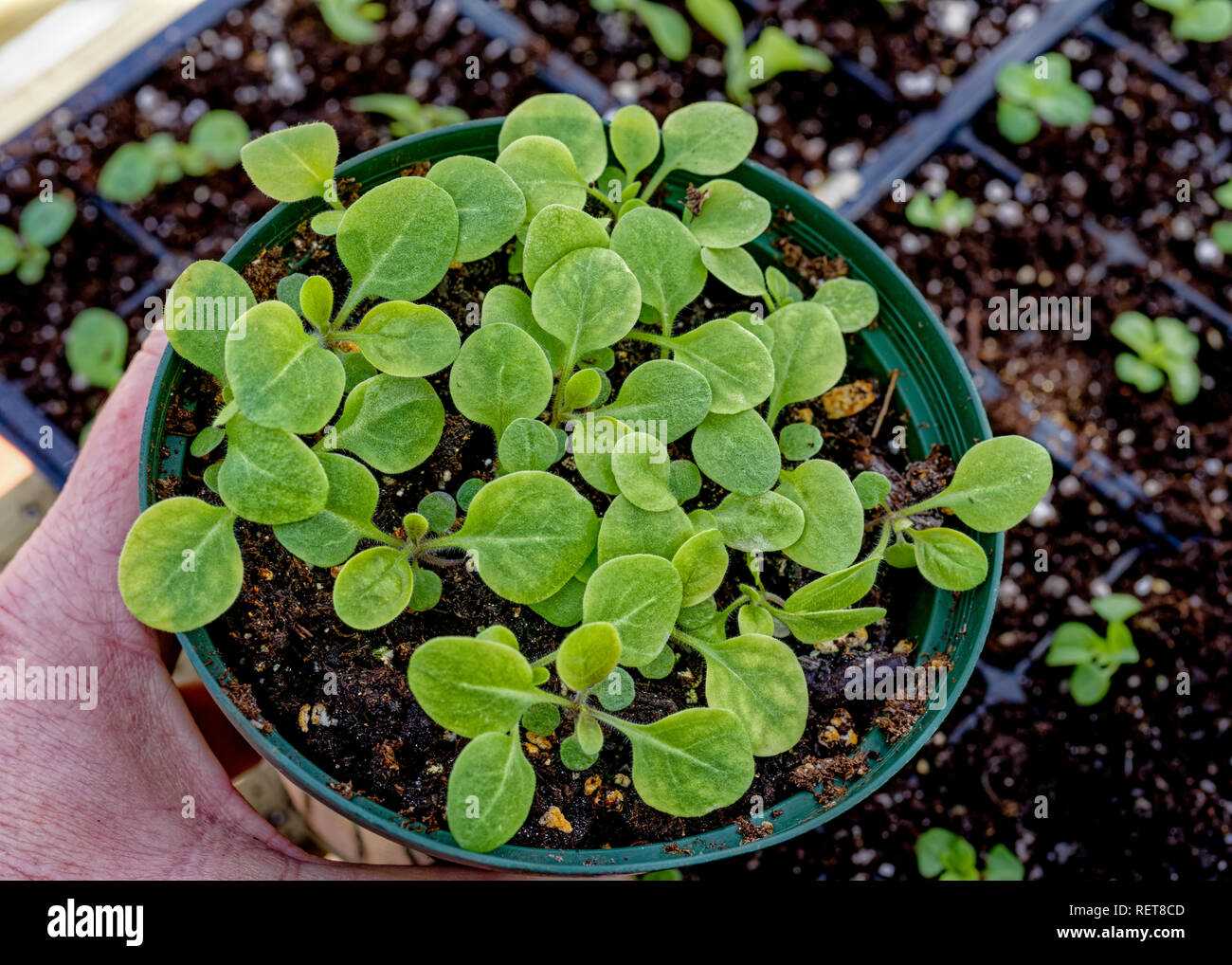
Carefully remove the ampel petunia seedlings from their seed tray or cell packs, taking care not to damage the delicate roots. Gently loosen the roots if they appear tightly bound. Dig a hole in the center of the container and place the seedling in it, ensuring that the top of the root ball is level with the soil surface. Fill in the hole with soil and pat it gently to remove any air pockets.
5. Watering and Care
After transplanting, water the ampel petunia thoroughly to encourage root establishment. Ensure that the soil is evenly moist, but not waterlogged. Monitor the moisture levels regularly and water as needed. Provide the plants with bright, indirect sunlight for 6-8 hours a day and protect them from extreme temperatures or frost.
6. Fertilization
Apply a balanced liquid fertilizer, formulated for flowering plants, every 2-3 weeks during the growing season to provide the necessary nutrients for optimal growth and flowering. Follow the instructions on the fertilizer package carefully to avoid over or under fertilization.
7. Pruning
To encourage bushy growth and promote more flowers, pinch or prune the tips of the ampel petunia plants. This will help to prevent leggy growth and promote lateral branching. Regularly remove any spent flowers to encourage continuous blooming.
By following these transplanting techniques, you can ensure that your ampel petunias thrive and provide a stunning display of flowers throughout the growing season.
Care Tips for Transplanted Seedlings
Once you have transplanted your ampel petunia seedlings, it is important to provide them with proper care to ensure optimal growth and flowering. Here are some care tips to follow:
1. Watering
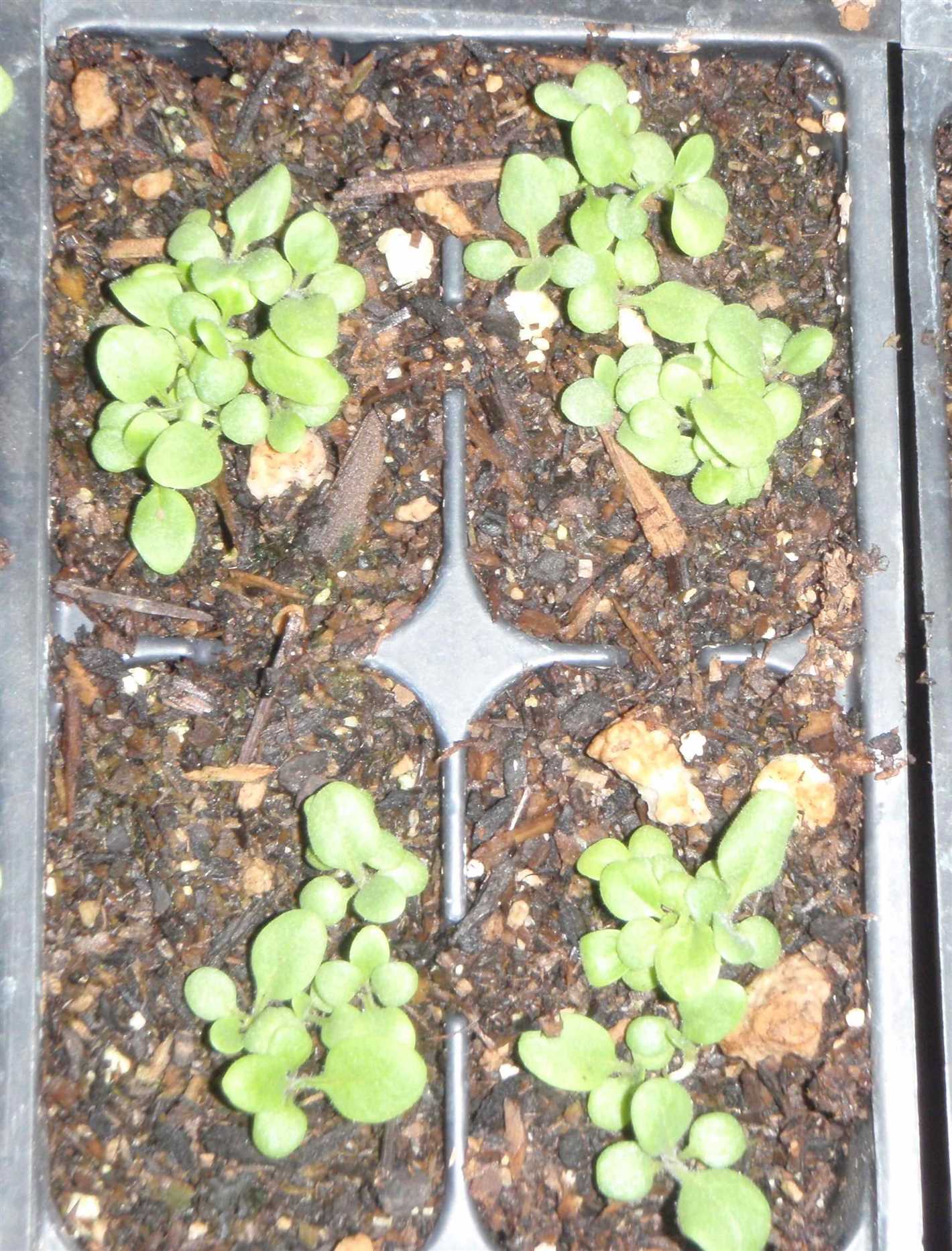
Water the transplanted seedlings regularly to keep the soil moist but not soggy. Avoid overwatering as it can lead to root rot. Check the moisture level by inserting your finger into the soil; if it feels dry about an inch below the surface, it’s time to water.
2. Fertilizing
Apply a balanced slow-release fertilizer to supply the transplanted seedlings with essential nutrients. Follow the manufacturer’s instructions for the proper amount and frequency of application. Alternatively, you can use a water-soluble fertilizer diluted to half strength and apply it every two weeks.
3. Sunlight
Place the transplanted seedlings in a location that receives full sunlight for at least 6 hours per day. Petunias love sun and need adequate light to thrive and produce abundant flowers.
4. Pruning
Regularly prune the ampel petunia seedlings to promote a more compact and bushy growth habit. Pinch off the tips of each stem with your fingers or trim them with clean gardening shears. This will encourage the development of lateral branches and result in more flowers.
5. Support
If you notice the transplanted seedlings becoming top-heavy or leaning, provide support to keep them upright. Use stakes or trellises to prevent the delicate stems from breaking or bending under their own weight.
6. Pest and Disease Control
Monitor the transplanted seedlings for any signs of pests or diseases, such as aphids, slugs, or fungal infections. Take prompt action to control and eliminate these issues, using organic or chemical treatments as recommended.
By following these care tips, you can ensure that your transplanted ampel petunia seedlings grow into healthy plants with optimal flowering. Enjoy the vibrant and colorful display they will provide in your garden or containers!
Benefits of Timely Transplanting
Timely transplanting of ampel petunia seedlings offers several benefits that contribute to optimal flowering and overall plant health. By transplanting the seedlings at the right time, you can:
- Promote Root Growth: Transplanting at the appropriate stage allows the roots to establish more quickly in the new growing environment. This promotes healthier root growth and improves overall plant vigor.
- Maximize Flowering Time: When ampel petunia seedlings are transplanted on time, they have a longer growing season to produce flowers. This leads to a more abundant and extended period of blooming, providing a more visually appealing display.
- Improve Plant Stability: Proper transplanting reduces the risk of toppling or damage to the plants due to wind or heavy rain. Well-established root systems help anchor the plants firmly in place, ensuring better stability and reducing the likelihood of plant breakage.
- Enhance Nutrient Uptake: Transplanting at the right time allows the young plants to access nutrients more efficiently. Diligently timed transplantation gives them the opportunity to better absorb essential nutrients from the soil, leading to healthier growth and development.
- Reduce Competition: By transplanting ampel petunia seedlings in a timely manner, you can minimize competition for resources like water, sunlight, and nutrients. This enables each individual plant to get the necessary resources for optimal growth, leading to stronger, healthier plants overall.
Overall, timely transplanting of ampel petunia seedlings is crucial for promoting healthy root growth, maximizing flowering time, improving plant stability, enhancing nutrient uptake, and reducing competition among plants. By carefully considering the appropriate timing for transplantation, gardeners can ensure the best possible results in terms of flower production and plant performance.
Troubleshooting Common Issues
1. Yellow leaves
Yellow leaves on ampel petunia plants can be a sign of several issues:
- Overwatering: Ensure that the plants are not being excessively watered. Too much water can lead to root rot and cause yellowing of leaves.
- Nutritional deficiency: Yellowing leaves could indicate a lack of essential nutrients like nitrogen, iron, or magnesium. Consider using a balanced fertilizer to provide the necessary nutrients.
- Pest infestation: Check for signs of pests such as aphids or whiteflies. These insects can cause damage to the plants, leading to yellowing of leaves.
2. Leaf spots
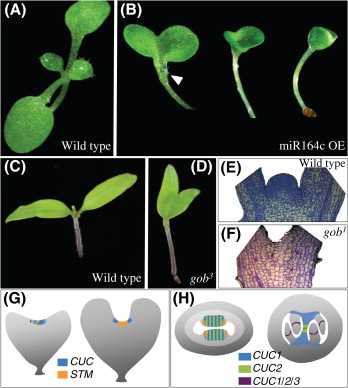
If you notice spots on the leaves of your ampel petunia plants, it may be due to:
- Fungal or bacterial infections: Leaf spots can be caused by fungal or bacterial diseases. Remove the affected leaves and treat the plants with appropriate fungicides or bactericides.
- Overhead watering: Wet leaves can create a favorable environment for fungal growth. Avoid overhead watering and instead water the plants at the base to minimize leaf wetness.
- Poor air circulation: Insufficient air movement can contribute to the development of fungal diseases. Provide adequate spacing between plants to promote air circulation.
3. Stunted growth
If your ampel petunia plants are not growing as expected, consider the following factors:
- Lack of sunlight: Petunias require full sun to thrive. Check if the plants are receiving at least 6-8 hours of direct sunlight per day. If not, consider moving them to a sunnier location.
- Temperature stress: Extreme temperatures, either too hot or too cold, can hinder plant growth. Ensure that the plants are kept in a temperature range suitable for petunias.
- Rootbound plants: If the plants are rootbound, meaning the roots have filled the container, they may struggle to grow. Transplant them into a larger pot to allow for root expansion.
4. Delayed flowering
If your ampel petunia plants are not flowering as expected, the following reasons could be responsible:
- Insufficient sunlight: Lack of sunlight can delay or inhibit the flowering process. Ensure that the plants are receiving adequate sunlight for their optimal growth and blooming.
- Overfertilization: Excessive use of fertilizers high in nitrogen can promote vegetative growth at the expense of flower production. Use a balanced fertilizer with a lower nitrogen content for better flowering.
- High temperatures: Extremely high temperatures can inhibit flower formation and cause buds to drop prematurely. Provide shade or move the plants to a cooler location during excessively hot periods.
By addressing these common issues, you can ensure the healthy growth and optimal flowering of your ampel petunia plants.
Questions and Answers:
Why is timely transplanting important for ampel petunias?
Timely transplanting is important for ampel petunias because it helps to avoid overexpression of seedlings and promotes optimal flowering. If the seedlings are not transplanted at the right time, they can become overcrowded and compete for nutrients, resulting in poor growth and reduced flowering.
When is the best time to transplant ampel petunias?
The best time to transplant ampel petunias is when the seedlings have developed their first true leaves. This is usually around 4-6 weeks after sowing the seeds. Transplanting them at this stage ensures that they have enough room to grow and prevents overcrowding.
What happens if ampel petunias are transplanted too late?
If ampel petunias are transplanted too late, they can become root-bound and stunted in their growth. This can lead to poor flowering and overall less healthy plants. It is best to transplant them at the right time to promote optimal growth and flowering.
How can overexpression of seedlings affect ampel petunias?
Overexpression of seedlings can negatively affect ampel petunias by causing overcrowding and competition for resources. When seedlings are overcrowded, they may not receive enough light or nutrients, resulting in poor growth and reduced flowering. Transplanting them at the right time can help prevent overexpression and promote healthier plants.
What should I do if my ampel petunias are overexpressed?
If your ampel petunias are overexpressed, you should carefully transplant them to larger containers or separate them into individual pots. This will give them more room to grow and prevent competition for resources. Be sure to water them well after transplanting and provide adequate light to promote recovery and optimal flowering.
Can I transplant ampel petunias directly into the ground?
Yes, you can transplant ampel petunias directly into the ground if the soil is well-drained and the weather conditions are suitable. However, it is usually recommended to start them indoors or in containers first, and then transplant them outside once they have developed their first true leaves. This gives them a better chance of establishing and thriving in the outdoor environment.
How often should I water ampel petunias after transplanting?
After transplanting ampel petunias, it is important to water them regularly to help them establish their roots in the new soil. Water them deeply at least once a week, or more often if the weather is hot or the soil is drying out quickly. Be sure to monitor the moisture level of the soil and adjust the watering frequency accordingly.







